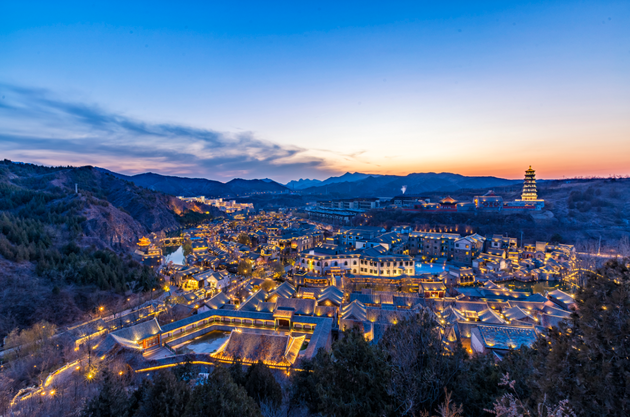
Gubei Watertown in the evening (Photo/Dfic)
Apr. 1 (NBD) -- On one evening of the spring, with the street lights glimpsing, the ancient Gubei Watertown at the foot of the Great Wall turns even more lively than the daytime. Some tourists are enjoying the music while drinking, some are rafting, and some are setting foot on the Great Wall, overlooking the town from Simatai.
"Night tour enriches the industries of the town and the tourist experience," Zhou Jianhong, general manager of a local tourism company, told the 21st Century Business Herald. Since the opening of the night tour, the number of tourists and revenue have seen a significant increase respectively.
Gubei Watertown is not the only destination that actively taps the night economy.
In February this year, the 600-year-old Forbidden City was lit up and open to the public for the first time in the evening, detonating the public's interest in night tours; Zigong, a city in Southwest China's Sichuan Province, puts on a lantern show at night each year since 1987, bringing its sluggish economy back to the forefront of Sichuan; Xi'an, banking on the Tang culture, is also ambitious in developing its night travel into a feature.
People's demand for nocturnal activity is gradually on the rise. According to Zhang Jiayi, a researcher at the key laboratory of the Ministry of Culture and Tourism, tourists traveled for three days on average last year, and 53 percent of them were willing to spend two nights on night tour.
Tiketing platform Lvmama showed the number of night tour products in 2018 recorded a year-on-year rise of 9 percent. Another booking platform Ctrip indicated the number of tourists participating in this year's new-year lantern show-related events soared by whopping 114 percent year-on-year.
"This is accredited to the change of Chinese tourist groups." Cao Xiaoning, general manager of a touring performance firm, pointed out that the group tour market has gradually shrunk, making the family-focused individual tour market more vigorous.
Young generations preferred diversified traveling experience and the dreamy atmosphere of nighttime lighting and the relaxing and casual consumption style help night tourism win popularity among them, Cao added.

Zigong's lantern show (Photo/Dfic)
Despite the brisk demand, the supply and demand of domestic night-time products still do not match. A report on night tour revealed the demand for night travel of tourists is manifold, but the night tour products lack diversity as festival events constitute nearly half of the total.
Dai Bin, president of the China Tourism Academy, observed the further development of the night tour sector is challenged by severe problems related urban infrastructure such as electricity, water supply, public transportation, public health, municipal administration, security and emergency rescue. Urban management department ought to step up efforts to strengthen infrastructure and pragmatically improve public governance, he noted.
Dai also claimed the tourism practitioners shouldn't merely focus on folk customs, but should draw on the experience of other regions with an open mind, and more talents of lighting design and city brightening should be fostered to apply their fashion and aesthetic tastes to the night tour projects, and monitor the quality of night tour services.
Lin Zhanglin, dean of the Joyu Institute of Culture&Tourism, believed creativeness is the foremost of all and the development and design of night tour products should follow the principle of participation and interaction, allowing visitors to find pleasure.
The blossom of the domestic night tour has also spurred the enthusiasm of capital investment. Report disclosed 81 percent of respondent companies are interested in expanding investment in the sector. But Dai warned night travel economy is still in the incubation period and all industries should carefully take care of the emerging segment.
Email: wenqiao@nbd.com.cn


 川公网安备 51019002001991号
川公网安备 51019002001991号





